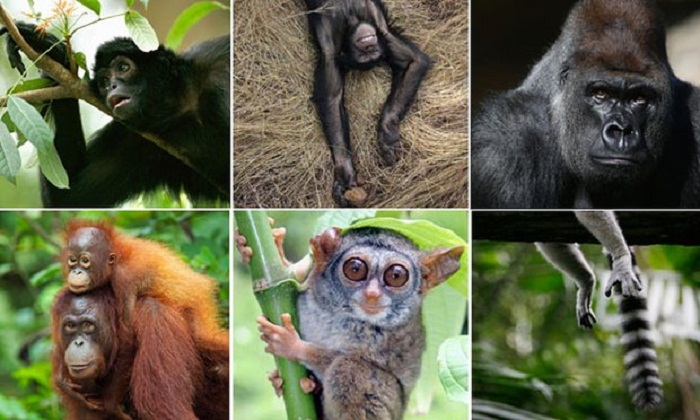Anthony Rylands, a senior research scientist at Conservation International who helped to compile the report, said he was “horrified” at the grim picture revealed in the review which drew on the International Union for the Conservation of Nature (IUCN) red list, peer-reviewed science reports and UN databases.
“The scale of this is massive,” Rylands told the Guardian. “Considering the large number of species currently threatened and experiencing population declines, the world will soon be facing a major extinction event if effective action is not implemented immediately,” he writes in the journal Science Advances, with colleagues at the University of Illinois and the National Autonomous University of Mexico.
The most dramatic impact on primates has come from agricultural growth. From 1990 to 2010 it has claimed 1.5 million square kilometres of primate habitats, an area three times the size of France. In Sumatra and Borneo, the destruction of forests for oil palm plantations has driven severe declines in orangutan populations. In China, the expansion of rubber plantations has led to the near extinction of the northern white-cheeked crested gibbon and the Hainan gibbon, of which only about 30 or animals survive. More rubber plantations in India have hit the Bengal slow loris, the western hoolock gibbon and Phayre’s leaf monkey.
Primates are spread throughout 90 countries, but two thirds of the species live in just four: Brazil, Madagascar, Indonesia and the Democratic Republic of the Congo (DRC). In Madagascar, 87% of primate species face extinction, along with 73% in Asia, the report states. It adds that humans have “one last opportunity” to reduce or remove the threats facing the animals, to build conservation efforts, and raise worldwide awareness of their predicament.
The market for tropical timber has driven up industrial logging and damaged forest areas in Asia, Africa and the neotropics. Mining for minerals and diamonds have also taken a toll. On Dinagat island in the Philippines, gold, nickel and copper mining endanger the Philippine tarsier. In the DRC, hunters working around the tin, gold and diamond mine industry are the greatest threat to the region’s Grauer’s gorilla. The industries at work in tropical forest areas are expected to be served by an extra 25m km of roads by 2050, further fragmenting the primates’ habitats.
While some species are resilient and adapt to the loss of traditional habitats, survival in patches of forest and urban areas is unlikely to be sustainable, the authors write. One of the more unusual threats facing lemurs and chimps who come into contact with humans is infection with diarrhoea-causing bugs.
Another major force driving primates to extinction is commercialised bushmeat hunting, which has expanded to provide food to the growing human population. The report cites accounts that claim 150,000 primates from 16 species are traded each year in Nigeria and Cameroon. In Borneo, between 2,000 and 3,000 orangutans are killed for food each year, a rate that is far from sustainable.
Russell Mittermeier, another Conservation International scientist and co-author of the study, said that it was crucial to target conservation on the most threatened forests and species.
“Clearly we need to deal with the drivers of extinction, from commercial agriculture to mining and logging. But if we focus all of our efforts on that, by the time we have had an impact, there won’t be anything left. So we must first protect the last remaining pieces of habitat and if no protected areas exist, we must create them.
“I’m an optimist and I believe we can come up with solutions, but we have to be very targeted now to make sure we don’t lose anything,” he said. Writing in the journal, the authors add: “Despite the impending extinction facing many of the world’s primates, we remain adamant that primate conservation is not yet a lost cause.”
/The Guardian/
More about:
















































